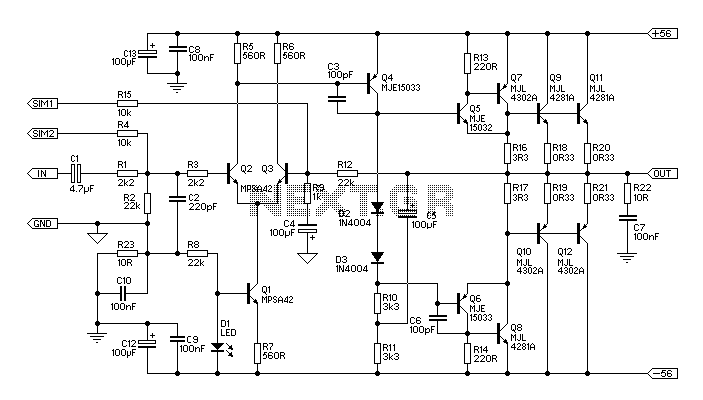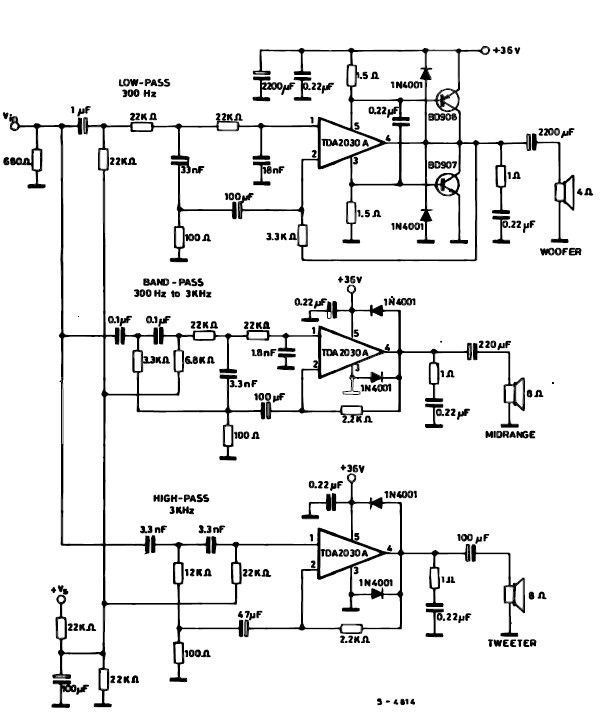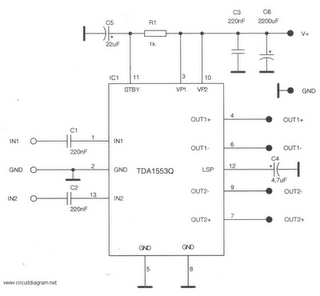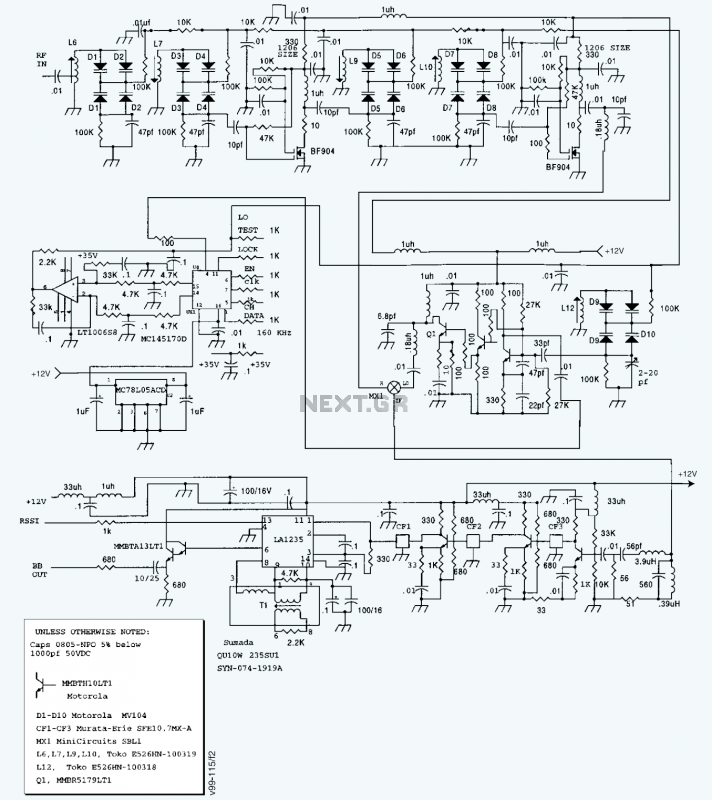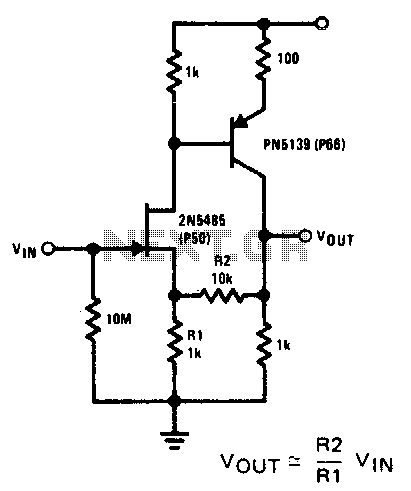
10W Audio Amplifier with Bass-boost
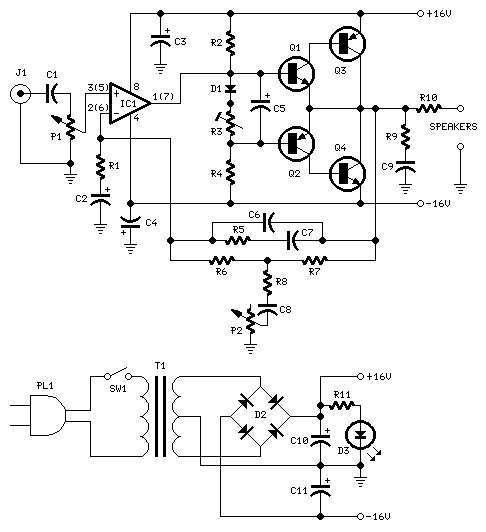
This design is based on an 18 Watt audio amplifier and was developed primarily to meet the needs of users who are unable to find the TLE2141C chip. It utilizes the widely available NE5532 dual integrated circuit; however, its power output will be limited to the range of 9.5 to 11.5 Watts, as the supply rails cannot exceed ±18V. Amplifiers of this type are frequently used to drive small loudspeaker cabinets, which may compromise the bass frequency range. To address this issue without sacrificing quality, a bass-boost control has been incorporated into the feedback loop of the amplifier. The bass lift curve can achieve a maximum of +16.4 dB at 50 Hz. Even when the bass control is fully counterclockwise, the amplifier's frequency response exhibits a gentle rise: +0.8 dB at 400 Hz, +4.7 dB at 100 Hz, and +6 dB at 50 Hz (referenced to 1 kHz). Proper grounding is essential to eliminate hum and ground loops. The ground connections for J1, P1, C2, C3, and C4 should be made at the same point, and C9 should be connected to the output ground.
The audio amplifier design leverages the NE5532 dual operational amplifier, which is renowned for its high performance in audio applications. The circuit is configured to operate within a supply voltage range of ±18V, ensuring that the output power remains within the specified limits of 9.5 to 11.5 Watts. This power output is suitable for driving small loudspeaker cabinets, which are commonly used in various audio applications.
To enhance the low-frequency response, a bass-boost control is integrated into the feedback loop. This feature allows users to compensate for the natural roll-off of bass frequencies that occurs in smaller speaker systems. The bass boost can provide a significant enhancement of up to +16.4 dB at 50 Hz, making it possible to achieve a fuller sound profile without introducing distortion or compromising audio quality.
The frequency response characteristics of the amplifier are designed to ensure clarity across the audio spectrum. When the bass control is set to its lowest position, the amplifier still maintains a gentle rising frequency response. This includes an increase of +0.8 dB at 400 Hz, +4.7 dB at 100 Hz, and +6 dB at 50 Hz, all referenced to 1 kHz. This response curve indicates that even without bass enhancement, the amplifier is capable of delivering a balanced audio output.
Grounding is a critical aspect of the circuit design, as improper grounding can lead to unwanted hum and ground loops. To mitigate these issues, it is recommended that all ground connections for components such as J1, P1, C2, C3, and C4 be tied to a single grounding point. Additionally, C9 should be connected to the output ground to maintain signal integrity and minimize noise interference.
Overall, this audio amplifier design provides a practical solution for users seeking an effective and high-quality amplifier that can be easily assembled using readily available components. The incorporation of bass-boost functionality and careful attention to grounding enhances the performance and usability of the amplifier in various audio applications.This design is based on the 18 Watt Audio Amplifier, and was developed mainly to satisfy the requests of correspondents unable to locate the TLE2141C chip. It uses the widespread NE5532 Dual IC but, obviously, its power output will be comprised in the 9. 5 - 11. 5W range, as the supply rails cannot exceed G‚ ±18V. As amplifiers of this kind are freq uently used to drive small loudspeaker cabinets, the bass frequency range is rather sacrificed. Therefore a bass-boost control was inserted in the feedback loop of the amplifier, in order to overcome this problem without quality losses. The bass lift curve can reach a maximum of +16. 4dB @ 50Hz. In any case, even when the bass control is rotated fully counterclockwise, the amplifier frequency response shows a gentle raising curve: +0.
8dB @ 400Hz, +4. 7dB @ 100Hz and +6dB @ 50Hz (referred to 1KHz). A correct grounding is very important to eliminate hum and ground loops. Connect in the same point the ground sides of J1, P1, C2, C3 &C4. Connect C9 at the output ground. 🔗 External reference
The audio amplifier design leverages the NE5532 dual operational amplifier, which is renowned for its high performance in audio applications. The circuit is configured to operate within a supply voltage range of ±18V, ensuring that the output power remains within the specified limits of 9.5 to 11.5 Watts. This power output is suitable for driving small loudspeaker cabinets, which are commonly used in various audio applications.
To enhance the low-frequency response, a bass-boost control is integrated into the feedback loop. This feature allows users to compensate for the natural roll-off of bass frequencies that occurs in smaller speaker systems. The bass boost can provide a significant enhancement of up to +16.4 dB at 50 Hz, making it possible to achieve a fuller sound profile without introducing distortion or compromising audio quality.
The frequency response characteristics of the amplifier are designed to ensure clarity across the audio spectrum. When the bass control is set to its lowest position, the amplifier still maintains a gentle rising frequency response. This includes an increase of +0.8 dB at 400 Hz, +4.7 dB at 100 Hz, and +6 dB at 50 Hz, all referenced to 1 kHz. This response curve indicates that even without bass enhancement, the amplifier is capable of delivering a balanced audio output.
Grounding is a critical aspect of the circuit design, as improper grounding can lead to unwanted hum and ground loops. To mitigate these issues, it is recommended that all ground connections for components such as J1, P1, C2, C3, and C4 be tied to a single grounding point. Additionally, C9 should be connected to the output ground to maintain signal integrity and minimize noise interference.
Overall, this audio amplifier design provides a practical solution for users seeking an effective and high-quality amplifier that can be easily assembled using readily available components. The incorporation of bass-boost functionality and careful attention to grounding enhances the performance and usability of the amplifier in various audio applications.This design is based on the 18 Watt Audio Amplifier, and was developed mainly to satisfy the requests of correspondents unable to locate the TLE2141C chip. It uses the widespread NE5532 Dual IC but, obviously, its power output will be comprised in the 9. 5 - 11. 5W range, as the supply rails cannot exceed G‚ ±18V. As amplifiers of this kind are freq uently used to drive small loudspeaker cabinets, the bass frequency range is rather sacrificed. Therefore a bass-boost control was inserted in the feedback loop of the amplifier, in order to overcome this problem without quality losses. The bass lift curve can reach a maximum of +16. 4dB @ 50Hz. In any case, even when the bass control is rotated fully counterclockwise, the amplifier frequency response shows a gentle raising curve: +0.
8dB @ 400Hz, +4. 7dB @ 100Hz and +6dB @ 50Hz (referred to 1KHz). A correct grounding is very important to eliminate hum and ground loops. Connect in the same point the ground sides of J1, P1, C2, C3 &C4. Connect C9 at the output ground. 🔗 External reference

